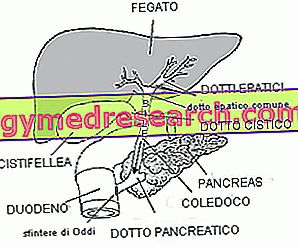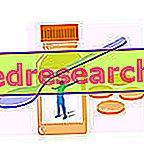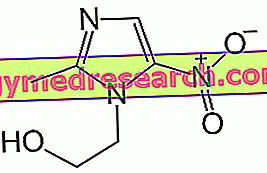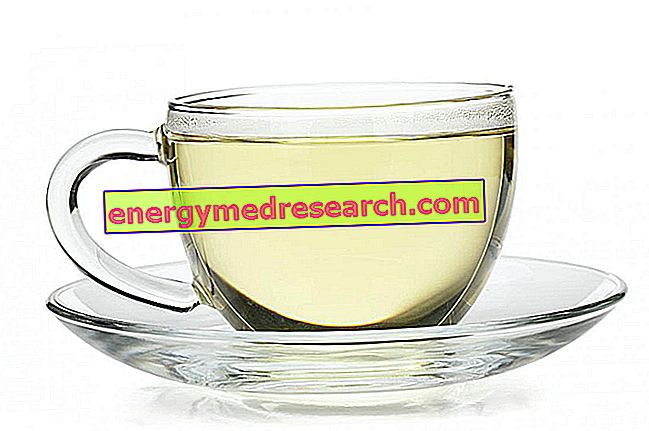See also: bile acids; biliary excretion of drugs
Bile is an isotonic aqueous solution produced by the liver and consists mainly of water (95%), electrolytes, lipids (bile acids, cholesterol and phospholipids), proteins and pigments (bilirubin); its pH is slightly basic.
Every day the liver produces an average of 600 ml of bile; the secreted quantity is influenced by the type of diet (increases following the ingestion of foods rich in fat), the frequency and consistency of meals, some drugs and the circadian rhythm (it is greater at night than in the day).

Towards the end of its path, the common bile duct flows into the greater pancreatic duct and finally, through the left side of the duodenum, flows into the papilla of Vater.
The speed with which bile flows into the intestine is regulated by the contractile fibers that make up Oddi's sphincter. This muscular ring, contracted during fasting and relaxed during the intestinal phase of digestion, prevents the reflux of the enteric content into the bile ducts; moreover, in conditions of fasting, it opposes resistance to the passage of the bile which, not being able to pour into the duodenum, runs through the cystic duct and pours into the gall bladder. Inside this vesicle, bile is accumulated and progressively concentrated (up to 10%); this reabsorption involves water, sodium chloride and bicarbonates, while bile salts, pigments and lipids are not reabsorbed and are increasingly concentrated.
Cholesterol, being insoluble in bile, would tend to precipitate in microcrystals (calculations); this is prevented by the presence of bile salts and phospholipids (lecithins) which, by incorporating it in micelles, prevent crystallization. However, it may happen that bile is supersaturated with cholesterol and that this is deposited in solid aggregates called calculations; for this reason, since the biliary elimination of cholesterol is directly proportional to the endogenous synthesis and to the quantity introduced with the diet, a balanced diet reduces the risk that this lipid precipitates in its crystalline form.
The emptying of the gall bladder occurs in connection with meals and is favored by the hormone cholecystokinin (CCK), produced by the mucosa of the duodenum in response to the passage of gastric contents (called chyme), especially if rich in fat. This hormone performs a triple action: it induces an increase in biliary secretion (choleretic action); stimulates the contraction of the gallbladder (cholagogue action); favors the relaxation of the Oddi sphincter, thus allowing the outflow of bile into the duodenum. Another hormone, called secretin, has the ability to increase bile flow (choleretic properties); other hormones, such as the vasoactive intestinal peptide (VIP), glucagon and somatostatin, promote the relaxation of the gallbladder and inhibit its contraction.
Bile salts and bile function
Bile secretion is essential for the digestion and absorption of lipids, thanks to the presence of bile salts. These molecules, polar derivatives of cholesterol, are amphipathic, in that they are formed by a liposoluble "face" and a water-soluble "back", with lots of negative charges directed towards the outside (it is called amphipathic or amphiphilic, a molecule containing a group hydrophilic and hydrophobic, the most classic example being the phospholipids that make up the cell membrane).
After being placed in the intestine, the bile salts are inserted into the lipid droplets with their liposoluble portion. In this way they reduce the cohesion between the various triglycerides, emulsifying the fat globules in small micelles and increasing the area accessible to specific pancreatic enzymes, called lipases, responsible for lipid digestion. Even the continuous mixing of the intestinal contents, favored by peristaltic contractions, contributes to the splitting of the lipid globules into much smaller molecules.

The whole process, which takes the name of emulsion, is irreversible since the lipid re-aggregation is prevented by the negative electric charge associated with the water-soluble component of the bile salts, which stabilizes the emulsion by repelling the various micelles.
In addition to facilitating the digestion and absorption of fat and fat-soluble vitamins, bile neutralizes the acidity of gastric secretions (HCl), stimulates intestinal peristalsis and exerts an antiseptic action against the bacterial flora, inhibiting putrefactive phenomena.
The products deriving from the degradation of hemoglobin (bilirubin), substances with toxic or pharmacological action and others of an endogenous nature (thyroid hormones, estrogen, etc.) are also removed from the body through bile.
Bile, bile salts and cholesterol
There are no biochemical mechanisms of cholesterol degradation in humans; therefore the only way of elimination of this lipid is its secretion in the bile and its conversion to bile salts. Every day the liver converts 200-400 mg of cholesterol into "primary" bile acids, represented by cholic acid and chenodeoxycolicle, in a 2: 1 ratio. These primary bile acids are released from the liver in conjugated form with the amino group of glycine or taurine; the bile acids conjugated with glycine (glycocolic and chenodeoxycholic acids) are present in three times higher quantities than the acids deriving from the conjugation with taurine (taurocolici and chenodeoxycholics).
Most of these salts (about 90%) are reabsorbed and return to the liver through the portal circulation, to then be secreted again in the bile juices. At colic level, some bacteria metabolize unabsorbed "primary" bile acids by converting them into "secondary" bile acids (deoxycolic and lithocolic acids), of which about 20% is absorbed and transported back to the liver via enterohepatic circulation.
An adult subject who follows a balanced diet produces an average of 7-20 grams of bile acids a day, of which only 200-500 mg are eliminated with the feces (quantity that increases if the diet is rich in fibers). The free cholesterol present in the bile is instead reabsorbed by 50%.



